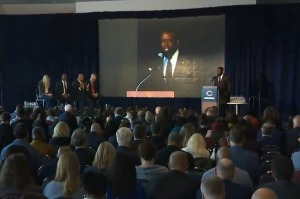128-Feet Jesus Statue Erected in War-Torn Syria as 'Middle-East's Symbol of Peace'
A 128-foot tall bronze statue of Jesus, christened "I have come to save the world," has been erected on a mountain top in war-torn Syria as a symbol of peace in the Middle East. The sculpture was built with support from an institution of the Russian Orthodox Church.
The statue, nominally taller than Rio de Janeiro's Christ the Redeemer statue, has been placed on a historic pilgrim route from Constantinople to Jerusalem, at the Cherubim Monastery in the community of Saidnaya, about 17 miles north of the city of Damascus, at an altitude of 6,889 feet above sea level.
"The ensemble with the blessing Christ in its center, seen from Lebanon, Jordan, Palestine and Israel, is designed to bring peace, mutual understanding, and hope for common salvation to a region engulfed in the flames of war," says the Moscow Spiritual Academy, which supported the project, in a statement, according to Interfax.
The statue, created by Armenian sculptor Artush Papoian, was the brainchild of Yury Gavrilov, a 49-year-old man from Moscow who runs an organization called St Paul & St George Foundation in London.
Samir Shakib El-Gabban, the director of the organization, was interviewed by Voice of Russia.
"After this idea emerged in 2005 it was blessed by Patriarch Ignatius IV of Antioch and the Middle East, who was the author of this idea," El-Gabban was quoted as saying. "Jesus Christ who is offering his blessings is trampling upon a snake, which is the symbol of evil. There is Adam on his right side and Eve on his left side. The Patriarch of Antioch chose the Cherubs' Mountain because cherubs, as is known, is a symbol taken from the Old Testament, which is used by the Christians and which is accepted by the believers of Islam."
Syrian priests, theologians from the Holy Trinity St. Sergius Laura in Russia and sculptor from Armenia were part of the eight-year project.
El-Gabban added it was practically impossible to bring the necessary equipment to the site because all roads were blocked. "Some of them were controlled by the rebels and some by the Syrian army. Hence, it was necessary to reach agreement with the two sides so that it would be possible to bring the equipment to the mountain peak, which was finally done. None of the two sides had fired a shot within the period of three days."
In Syria, a civil war between President Bashar Assad's supporters and rebel forces seeking to overthrow him has taken the lives of more than 100,000 people over the last two years. As a result of the war, more than 2 million people have fled the country. Many of those who have fled are ethnic Armenians.




























